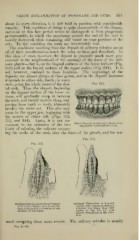Page 951 - My FlipBook
P. 951
CALCIC INFLAMMATION OF MEMBRANE AND GUMS. 961
about in every direction, it is still held in position with considerable
tenacity. This condition of things is quite characteristic of the disease,
and even at this late period serves to distinguish it from phagedenic
pericementitis, in which the membrane around the end of the root is
usually destroyed, while remaining still intact on some portions of the
side. In this condition the teeth are irretrievably lost.
The conditions resulting from the deposit of salivury calculus are in
all of their manifestations much the same as those just described. In
this class of cases, however, the deposit is generally much more pro-
nounced in the neighborhood of the openings of the ducts of the sali-
vary glands—that is, on the lingual surfaces of the lower incisors (Fig.
510) and on the buccal surfaces of the upper molars (Fig. 511). It is
not, however, confined to these localities. The beginnings of the
deposits are almost always at these points, and as the deposit increases
it spreads to either side, finally, in many
eases, going the whole round of the den- Fig. 512.
tal arch. Thus the deposit, beginning
on the lingual surface of the lower in-
cisors, will gradually creep in between
the teeth, and finally encircle them, and,
passing from tooth to tooth, ultimately
involve the entire set. This also may
occur in the upper jaw, beginning with
the molars of either side (Figs. 512,
518, and 514).. Again, it is not un-
Heavy Deposits of Salivary Calculus caus-
conmion to see mixtures of the two ing general Calcic Inflammation.
kinds of calculus, the salivary occupy-
ing the necks of the teeth near the ducts of the glands, and the ser
Fig. 514.
Fig. 513.
Sectional Illustration of a heavy Deposit Sectional Illustration of Inferior
of Salivary Calculus on a Lower In- Incisor with Iiepo.sit of Salivary
cisor, with pnrtial Destruction of the Calculus less heavy than that
Alveolus of the Tooth. shown in Fig. .512, but with
greater Destruction of the Alve-
olus.
umal occupying those more remote. The salivary calculus is usually
Vol. I.—61


